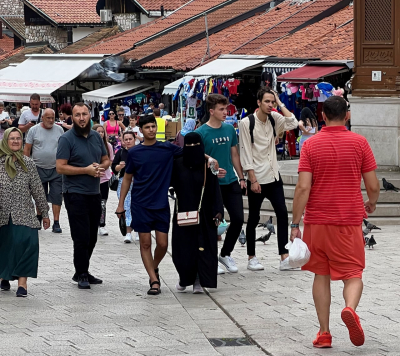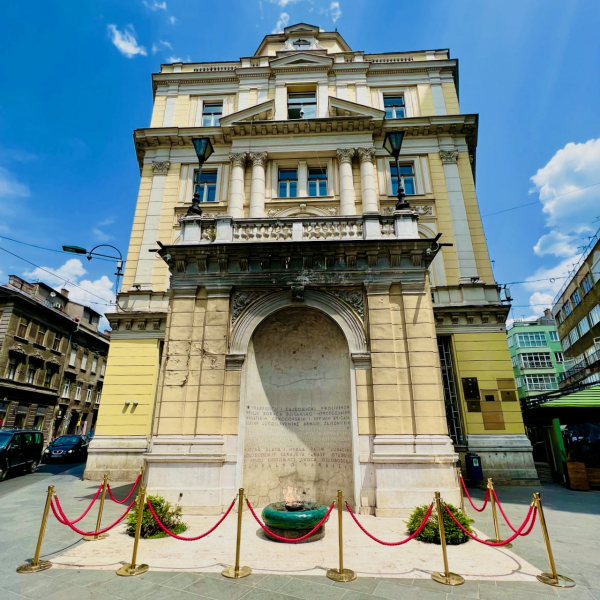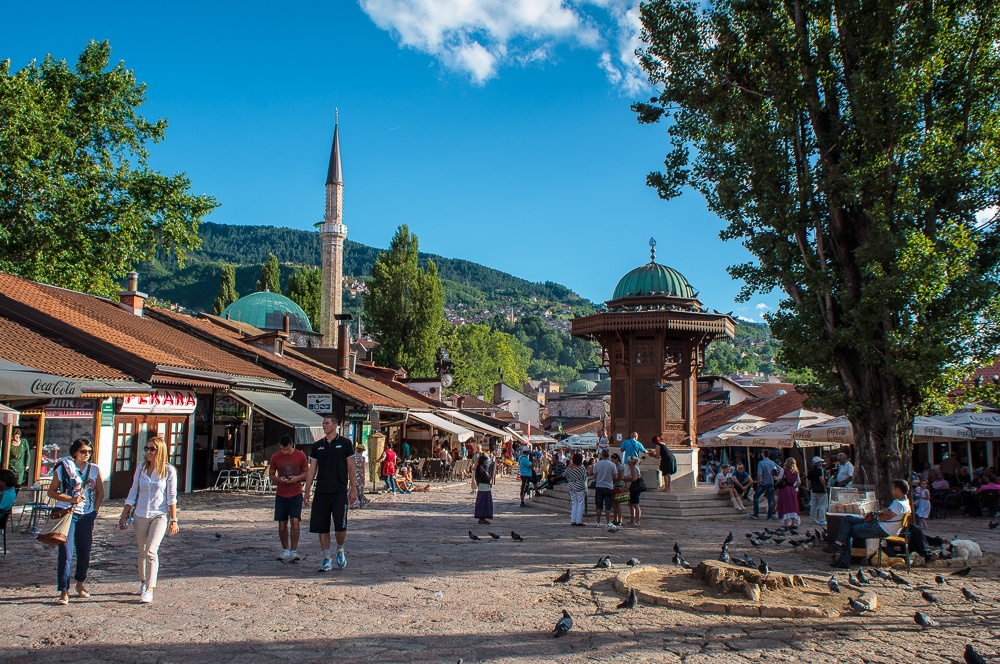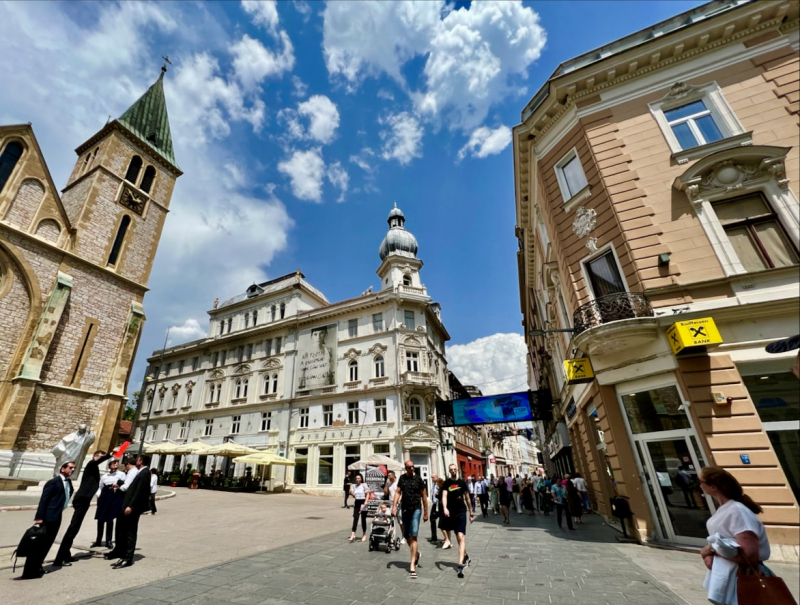What do you think of when you hear Sarajevo?
Depends on how long you’ve been around here on Earth, perhaps. I remember the Sarajevo Winter Olympics in 1984, the first Winter Games held in a socialist country. That could be because I hail from Norway, where Winter Olympics far outweighs summer ones in importance. Mostly though, I think of Sarajevo as a city with a dramatic and tragic past.
In school, we learnt about The Gunshots in Sarajevo, when the heir to the Habsburg throne, Franz Ferdinand and his wife Sophie, were assassinated on a fateful summer day in June 1914, setting off the events that led to World War I one month later.
More recently, the city was in the middle of the Yugoslav Wars of the 1990s. Bosnia & Herzegovina had declared itself a sovereign nation, after a referendum where 99.7% voted in favour of independence. Of course, the voter turnout was only 63.4%, as most of the Serb population boycotted. But the new country was internationally recognised, and war ensued. The city of Sarajevo was under siege from April 1992 – February 1996, the longest siege of a capital in all of modern warfare. During those nearly four years, ca. 11,000 people were killed in Sarajevo alone.
Today, Sarajevo is the national capital of a divided nation. According to the terms of the 1995 peace agreement known as the Dayton Accords, power is shared by Serbs (49%) and Bosniaks/Croats (51%). The Serb part is called Republika Srpska, whilst the Bosniak/Croat part is known as The Federation of Bosnia and Herzegovina.
11 things you’ll love in Sarajevo
Sarajevo is one of Europe’s more obscure capitals – and you know we like that here on Sophie’s World. It is also a pleasant, very walkable city. Wandering through the Ottoman Old Town, it’s easy to imagine you are transported back 100 years. Of all the cities we visited on a recent road trip through the Balkans, Sarajevo was the most fascinating cultural fusion: a mix of people, religion, dress, architecture. Cathedrals, mosques and synagogues live practically next to each other.
Sarajevo doesn’t get many tourists, at least not yet (around 730,000 visitors in 2019). In July 2022, in high tourist season, we hardly met – or heard – any.
Now, we were in Sarajevo for a day and a half. Just a taste, really; enough to whet the appetite. I suppose I could have called this post 36 hours in Sarajevo. With that out of the way, let’s get on with it.
1. Vijećnica – Sarajevo’s City Hall

This is Vijećnica, Sarajevo’s elegant City Hall. Built in 1896 during the Habsburg era, it was destroyed by Serbian shelling in 1992, during the siege. It has since been rebuilt to its former glory; it reopened in 2014, and is absolutely worth visiting.



Note the gorgeous stained-glass ceiling, and the main staircase – how it looks today vs. how it looked after the 1992 shelling. Also, don’t miss Courtroom no. 2 of the Hague Tribunal, where war criminals from the former Yugoslavia were prosecuted. (More information on The International Criminal Tribunal for the former Yugoslavia (ICTY) is here.)
Everything was moved here from The Hague in 2018.
2. Museum of Crime Against Humanity and Genocide (1992 – 1995)

The Museum of Crime Against Humanity and Genocide was founded by surviving victims together with young researchers. Located near the cathedral, this small museum is very easy to find. It is privately run, with no state funding, so it’s a bit amateurish put together, but somehow that makes it more real. This happened to people like you and me. I’m reminded this could in fact be me, but for luck of birthplace. It can be a bit overwhelming. But so it should.
We see exhibits on children as war victims, concentration camps, torture and mass killings at Srebrenica, and on the perpetrators. Personal items from both victims and criminals are shown, including torture instruments and very graphic, disturbing photos. There is a model of a solitary confinement cell and a replica mass grave. Human stories behind each and every item.
Films show the story of the siege, stories from eye-witnesses and victims; one is about sexual violence. One room is dedicated to visitors: their messages on post-its. Info on opening hours and more here.

Thousands of messages
3. Stari grad (Old Town) with Baščaršija, the Ottoman bazaar

Along the northern bank of the Miljacka River, the colourful Baščaršija is the old Ottoman merchant district, heart of Sarajevo’s old town, and where the city was founded ca. 550 years ago. You’ll recognise the word, I’m sure: bazaar. This is where the city’s cultural diversity is most apparent.

In the old days, Baščaršija was the most important trading centre in the Balkans, with 1,000+ shops lining the narrow streets, representing more than 80 crafts: jewellers, saddlers, bakers, taylors, blacksmiths, quiltmakers, etc., each with their own street. Today, it’s mostly souvenir shops, but often selling traditional handicraft created by local artisans.
You’ll also find small guest houses, cafes serving local dishes, churches, synagogues and mosques, most famously the Baščaršija Mosque with its 35-metre tapering minaret.
4. Sarajevo Sebilj Fountain

The Sebilj Fountain is in the middle of Baščaršija, a drinking fountain from the late 1800s. The surrounding square has several cafes and restaurants, and a continuous pigeon party.
4. Steep picturesque hills

In case you thought Sarajevo was flat, think again. The city is surrounded by forests, hills and mountains (it has been venue for the Winter Olympics, remember). In the old town, across the street from the pigeon-y square, you can climb steep, cobbled streets with more cafes and quirky shops.
5. The Miljacka River and all its bridges

Photo by Andrew Morland
Sadly, we didn’t have time to take the cable car up to Trebević mountain. Amazing city views of Sarajevo’s 20 bridges, I’m sure. Some old, some new. Most famous is the Latin Bridge, which you can get a glimpse of above here, behind the car. And that brings us to…
6. The Gunshots in Sarajevo

The Latin Bridge is famous, or perhaps infamous, rather, as the spot where a Serb terrorist assassinated archduke Franz Ferdinand, heir apparent to the Habsburg throne, and his wife Sophie von Hohenburg.
On 28 June 1918, Franz Ferdinand and Sophie were on their way to a meeting in City Hall, when a Serbian terrorist threw a bomb at their 6-car motorcade, but missed his target. Once inside City Hall, Franz Ferdinand stopped the mayor’s welcome speech, and said
Mr. Mayor, I came here on a visit and I am greeted with bombs. It is outrageous.
On the way back from City Hall, their driver took a wrong turn. As he accidentally stalled the car while trying to reverse, another Serbi nationalists, 19-year-old Gavrilo Princip, climbed up on the footboard, and shot and killed Franz Ferdinand and Sophie at point-blank range. This set off a chain of events that led to the start of World War I, exactly one month later.
And what happened to the assassin? According to Habsburg law, the minimum age for execution was 20. Princip was 27 days too young, so received the maximum prison sentence, 20 years in Terezin, 50 km from Prague. He was in solitary confinement, and chained to the wall, and died of tuberculosis four years later.
So his final resting place wouldn’t be a shrine for nationalists, the prison guards buried him in an unmarked grave. Rumours (or possibly conspiracy theories) has it, this was at Bohnice cemetery outside Prague. Later, he was exhumed and re-buried in Sarajevo.

A plaque on the wall marks the spot
Just across the street from the Latin Bridge is Muzej Sarajevo 1878–1918 (Sarajevo Museum). The car outside the museum is a replica of the Gräf & Stift Double Phaeton, the open-topped touring car Franz Ferdinand and Sophie were travelling in when Princip assassinated them. The original car is on display at the Museum of Military History in Vienna.
7. Vječna vatra, the eternal flame

A 10-minute walk from Baščaršija, the eternal flame is a memorial to the liberators and victims of World War II. An open flame is always burning, symbolising that they will always be remembered.
8. The Sacred Heart Cathedral

In the Old Town, the Neo-Gothic Sacred Heart Cathedral is the largest in Bosnia and Herzegovina and the symbol of Sarajevo.
9. Cafes, restaurants, pubs and bars
Surrounding the cathedral are several cafes and restaurants (outdoors in summer), and just a few streets away from the Old Town is Sime Milutinovića Sarajlije street, where you’ll find plenty of cheerful pubs and bars. We liked Central Cafe, Caffe Ort – and of course Tesla Pub.


For the last two, let’s go out of town. You can travel to both with your own wheels, by bus, or you can take a day tour with one of several tour companies.
10. A day trip to Mostar
130 km (a 2hr15min drive) from Sarajevo is the beautiful UNESCO-listed Mostar, with the iconic Stari Most that was bombed to pieces in 1993. The ancient Ottoman bridge became a symbol of the destruction of the Balkan Wars in the 1990s, and was rebuilt in 2004, using the same materials as the original one 500 years ago.
Mostar looked much the same as it did when I was last there in 2004, with one exception: Many more tourists. Many, many more. Still, a worthwhile visit.
11. A day trip to Međugorje
A further 30 minutes in the direction of Dubrovnik, is Međujgorje, famous for Virgin Mary sightings by six children in 1981. It has become a place of pilgrimage, on par with Lourdes in France and Fatima in Portugal, with worshippers from all over the world. It’s an odd, but interesting experience.
Next time in Sarajevo
A day and a half isn’t long. Sarajevo and its surroundings need more time than 36 hours. Next time, I would especially like to visit these two:
→ Sarajevo war tunnel
Built in 1993 during the Siege of Sarajevo, the war tunnel (also known as the Tunnel of Hope), linked the occupied city with the UN-controlled area on the other side of the airport. Through this almost 1-km long tunnel, food and weapons were brought into the city – and people travelled back and forth.
→ Srebrenica
An even more sobering experience must surely be a visit to Srebrenica, scene of a brutal slaughter during the Yugoslav Wars, known as the Srebrenica genocide. During one week in July 1995, Serb forces executed almost 8,000 Bosniak men and boys.
Twin and friendship cities
Considering that the fate of the country was decided at an international summit on an airforce base near Dayton, Ohio in the USA, it’s not surprising Sarajevo is twinned with Dayton. But plenty of other cities around the world are twin or friendship cities with Sarajevo as well, including Coventry, Baku, Innsbruck, Venice, Kuwait City, Barcelona, Skopje, Naples, Belgrade, Ljubljana, Salt Lake City and many more.

Sarajevo practicals
- There are direct flights to Sarajevo International Airport from many cities in Europe (e.g. Paris, Frankfurt, Warsaw, Oslo, Istanbul) and the Middle East (Dubai, Abu Dhabi, Kuwait City, etc.)
- Trains from abroad can be a bit tricky. There was a direct train from Zagreb to Sarajevo, but not anymore, due to disagreements between the rail companies of the two countries. Local trains operate, including a twice daily route between Sarajevo and Mostar. It’s a pretty journey and takes about 2 hours. Info on times and prices here.
- InterCity busses go between Sarajevo, Mostar, Međugorje, Banja Luka, Tuzla and Zenica. As of July 2022, you cannot buy tickets online, so get them at the bus station (the day before is best) or on the bus. More info here.
- Rental car. It is fairly simple to rent a car in one Balkan country and returning it in another. Just remember to get all the necessary documentation, including a cross border authorisation and a green card – insurance covering all the countries you want to visit (or even just drive through).
- Hotels, hostels, AirBNBs, spa resorts and guest houses are easy to find, and quite affordable. We enjoyed the comfortable Hotel Central, which, as the name correctly implies, is very centrally located next to the Cathedral, just metres from the Ottoman Old Town and lots of restaurants and bars – and it has an indoor pool. (Nope, nothing sponsored).

